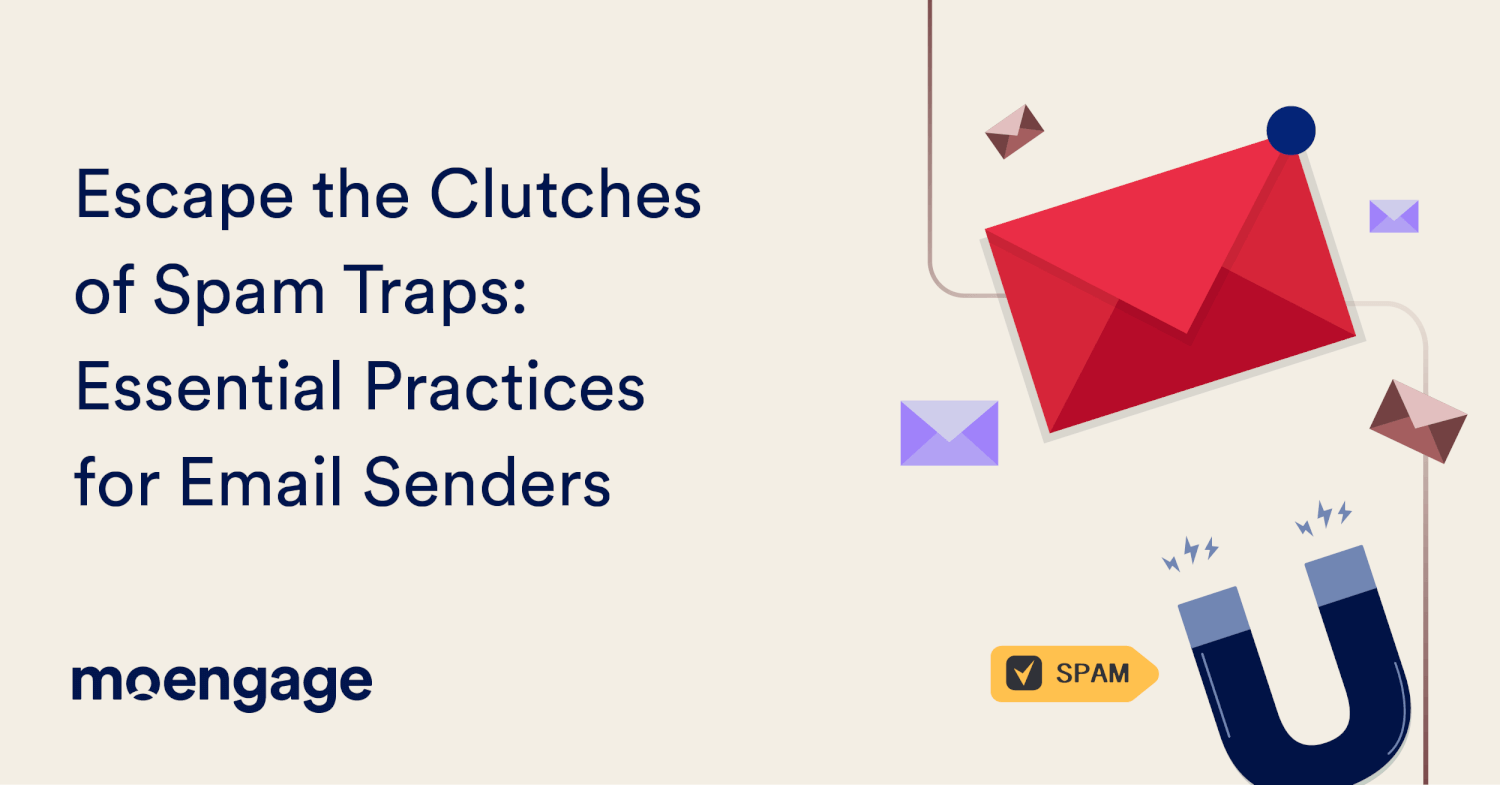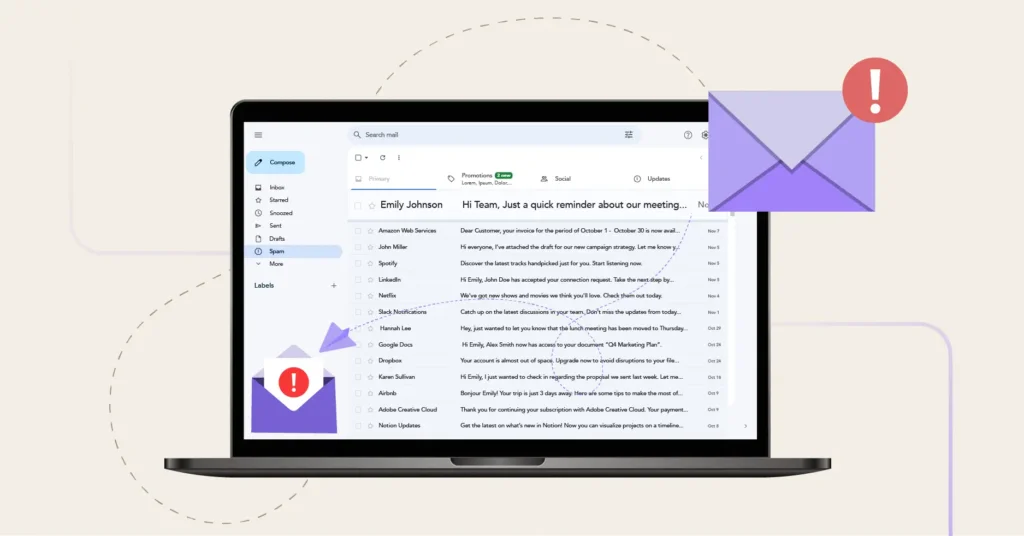Escape Spam Traps: Essential Practices for Email Marketers

Reading Time: 6 minutes
Have you ever left old food in your fridge, and it starts to smell? It’s like that for email marketers when they forget to clean their email lists, triggering spam traps.
But how do you know your list quality is going downhill? And why do you need to?
Well, you can look at the percentage of invalid addresses, the sender’s reputation, and the sender score of the IP addresses to see if your contact list has invalid email addresses. Because you don’t want your sending reputation to take a hit, do you? But before discussing the how and the why, let’s find out…
What Are Spam Traps?
Spam traps or honeypots are invalid email addresses that are either created or repurposed by mailbox providers to assess email senders’ list management practices and catch spam.
Emails are delivered to spam traps the same way they’re delivered to other legitimate email addresses, making it impossible for a spammer to identify a trap.

If there were loopholes for avoiding spam traps without following a list of hygiene and deliverability best practices, it would not be effective in identifying spammers. This is why email validation tools often do not catch all honeypots.
However, honeypots never engage with emails, so you can analyze email engagement data to identify them.
Why Is It Important To Avoid Spam Traps?
If you don’t clean your email list frequently, the number of honeypot email addresses on your list will keep growing. When this happens, you will no longer know if your sender reputation is affected or if anti-spam organizations have already flagged you for sending unsolicited emails.
Eventually, you will no longer be able to identify which cohort of email addresses are honeypot addresses, which are genuine subscribers, which are only generating negative engagement, and which ones are no longer interested in your brand. All of these affect your sender’s reputation and email deliverability.
Types Of Email Spam Traps

From poor customer email collection methods to a lack of list hygiene or a lack of sunsetting, there can be multiple ways in which a list quality can drop. Accordingly, multiple types of email spam traps are created to flag different types of issues:
1. Pristine Spam Traps
Pure or pristine spam traps are email addresses that nobody has ever used. ISPs and other organizations create these traps to embed them into websites, thus identifying spammers.
The only way to avoid this kind of trap is by sending your emails to legitimate senders who have clearly opted in to your emails.
If your emails consistently hit pristine spam traps, it’s a tell-tale sign that your email list collection methods are off. You might also be sending emails to a contact list of unsolicited customers or simply sending spammy emails to your existing customers.
Typically, pristine traps end up in your list if you’ve purchased lists, or scraped email addresses or a contact list from public forums.
2. Recycled Spam Traps
Mailbox providers suspend email addresses that have been inactive for a long time. When this happens, these emails are hard-bounced. Brands should suppress these permanently; if not, they will be converted into spam traps.
A recycled trap was once a legitimate email address. Some email validation tools use this pre-existing pool of invalid customers to flag recycled spam traps and protect their sender’s reputation.
Senders with good list hygiene and who don’t send unsolicited emails will never face such a trap. Consistently hitting recycled honeypots is a sign of poor list hygiene.
Recycled traps typically indicate purchased lists, usage of an old email address, lack of sunsetting, or issues with suppression policies.
Pro Tip: While migrating from one vendor to another, ensure that you are migrating either all suppressed addresses or the most recent (last 3-6 months) engaged and delivered customers. Otherwise, you will have high-recycled traps and a bad audience quality.
3. Typo Spam Traps
Typo spam traps are simply misspelled email addresses or email addresses created with a minor mistake. They trigger the least amount of spam filters and have a lesser impact on your email deliverability. Some common examples include: [email protected] instead of [email protected], or [email protected] instead of [email protected].
This kind of trap can get into your email list when customers misspell their email address while opting in.
As a legitimate sender, you should ask for double opt-ins or prompt customers to re-enter their email addresses when building a contact list to prevent traps like these.
What Happens If You Send Emails To Spam Trap Email Addresses?
Spam traps are created to flag spammers. If you consistently hit spam traps, you would be deemed a spammer. When this happens, all emails from your domain/IP will be treated as spam by internet service providers (ISPs).
The only way spam traps could get into your contact list is if your audience collection methods are not clean or secure, if you purchase lists, do not suppress invalid customers, or if you do not sunset subscribers due to inactivity.
All such practices and invalid contact lists are flagged by internet service providers. Over time, these behaviors negatively affect your domain’s sender reputation.
Moreover, your sending IP address will be flagged for sending spam. Your delivery rates could drop, and your emails will be sent to the junk folder. If your email messages go to the spam folder, engagement rates and sending reputation will take a direct hit.
Emails from your IP/domain might be rejected, rate-limited, or sent directly to the spam folder. Your overall domain and IP reputation will decrease. Essentially, in varying degrees, the impact could be:
- Delayed delivery (emails would get rate-limited and deferred)
- Low delivery (emails would get soft bounced, i.e., will not be delivered)
- Low engagement (emails would be sent to the spam folder)
- Drop in the domain and IP reputation.
How to Identify Spam Traps
If you find your email deliverability rate is dropping steadily, your list could contain a honeypot. How? This is because these traps don’t read or respond to emails they receive.
The typical features of a spam trap are:
- The email address appears invalid or outdated.
- It has typos.
- It’s acquired through bulk email list purchasing or other suspicious means.
Tools like SpamCop can help you analyze your contact list for honeypots.
Identified one already? It’s time to learn how to prevent them altogether.
How to Avoid Spam Traps

The short answer is to have a better list management process. These steps can help you avoid and remove spam traps while also keeping your list healthy.
1. Secure your email address collection methods
Use double opt-in for all your subscribers so they can confirm their email addresses. This ensures that the email addresses they’re entering are legitimate and helps you verify that they want to receive emails from you. Such confirmed opt-ins prevent recycled traps as well as typo and pristine traps.
2. Send confirmation emails for authentication
As soon as a customer subscribes to your email list, you should send them a confirmation email to make sure the email address provided is real. For example, Wix sends an email asking you to confirm your email address after you sign up on their platform.
If you don’t receive any confirmation from your customer within 24-48 hours after sending the email, consider removing their email address from your list.
3. Don’t buy contact lists
We can’t stress this enough. Purchased email lists are a magnet for spam trap emails. Even if they do contain legitimate subscribers, there’s no guarantee that those subscribers would want to receive your content. Because they haven’t explicitly given you their consent to send them emails!
4. Sunset inactive addresses
A best practice is to remove the email address of a customer who has not engaged in over nine months. It’s also a good idea to suppress role addresses. Some organizations even use role addresses like [email protected] or [email protected] as traps.
If you still see issues or need to clean your existing list, get help from other organizations for list validation, followed by re-permissions, while employing double opt-in for new sign-ups.
Pro Tip: If you haven’t sent emails in a long while (3+ months) or have consistently faced issues with block lists despite having a well-crafted email strategy, consider getting re-permission to affirm opt-in.
Wrapping Up
To summarize, ensure your list management strategy is aiding your email deliverability. Secure your email signup forms, stick to permission-based email marketing, remove inactive subscribers, never use purchased lists, remove outdated emails, do not pull email addresses by scraping sites like public websites, and so on. This will automatically prevent spam traps from getting into your list.
All in all, stay away from any suspicious methods to inflate your email contact lists.
Your email address collection points should be secure and there should be mechanisms, be it double opt-in or onboarding lifecycle journey post-sign-up, to identify a real person interested in your brand, instead of invalid email addresses or inactive subscribers, which could be a honeypot.
After gathering contacts, you monitor their behavior, engage them, reengage them, and, when that doesn’t work, suppress them permanently. This is how you can stay ahead of the curve.
Overwhelmed? Talk to MoEngage!








